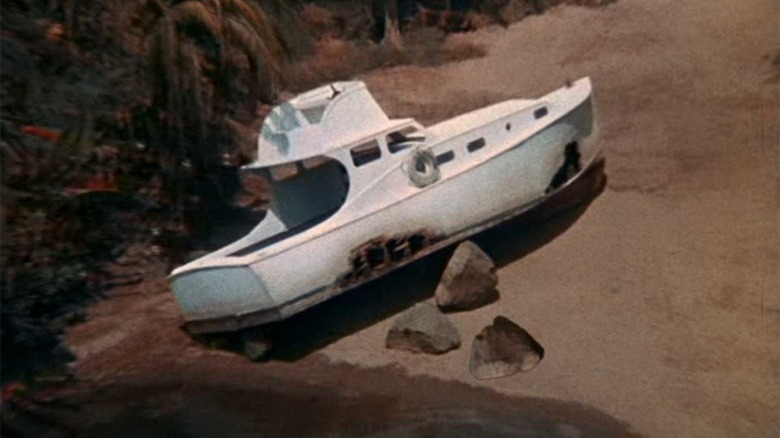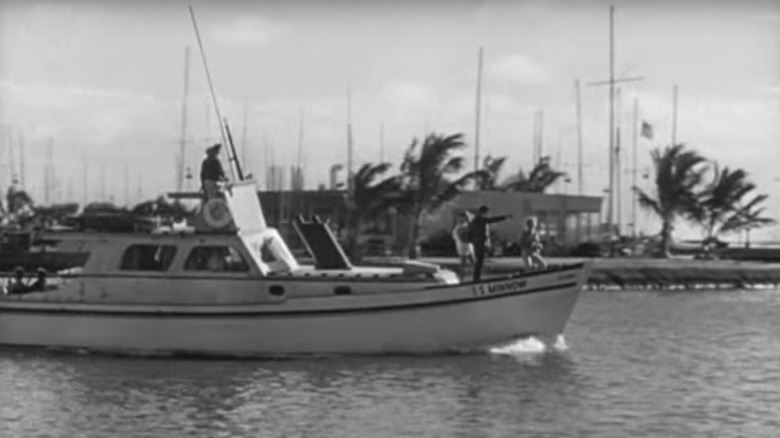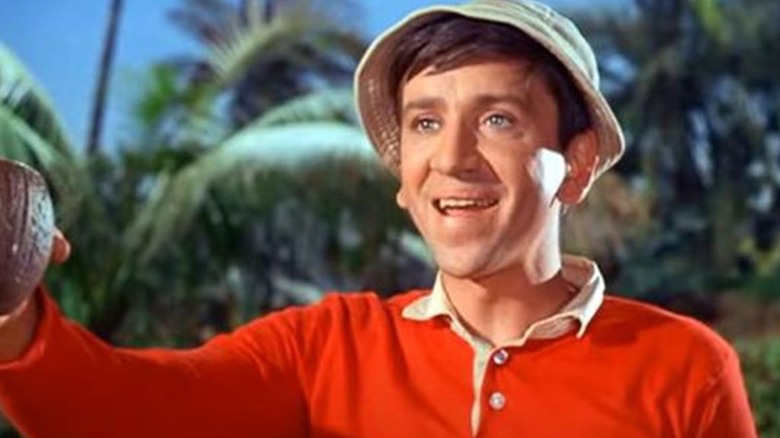Destroying The Gilligan's Island Boat Hilariously Mystified A Local Old Man
Thanks to the imminently catchy theme song to Sherwood Schwartz's 1964 sitcom "Gilligan's Island," generations of TV fans know the premise of the series, even if they haven't seen a single episode. The song, fashioned after old-timey sea shanties, explains that five passengers, a captain, and his first mate, all boarded a small sightseeing vessel for a three-hour tour. They hit some bad weather on their voyage and crash-landed on an uncharted desert isle. The ship, the S.S. Minnow, was irreparably damaged, and the seven stranded castaways have to learn to survive together, usually to comedic effect.
Most of the series was filmed in California, but certain exteriors, especially early in the series, were filmed on the island of Kauai in Hawai'i. Schwartz recounted every possible detail of the filming in his invaluable book "Inside Gilligan's Island: From Creation to Syndication," published in 2010. To shoot the show's opening sequence, Schwartz needed a local ship to serve as the S.S. Minnow. Specifically, he needed a small passenger ship that could hold five civilians in addition to a captain and a first officer. More specifically, he needed a ship with a flying bridge. A flying bridge, also known as a monkey island, is an elevated platform on top of a small vessel where crew members can have an unobstructed 360-degree view.
Most specifically, Schwartz needed a seven-person vessel with a flying bridge that he could smash a hole in the side of. This was to be the damaged ship, seen in the photo above, to be used for the opening sequence. Of course, smashing a hole in a ship with a hammer drew some curious lookie-loos who didn't understand why people were smashing up a perfectly decent ship.
Smashing the Minnow
According to Schwartz, he and his filming crew managed to find an appropriate ship on November 18, 1963, only one day before filming was scheduled to begin. There was an element of urgency, as the ship was located by the show's scouts floating in Honolulu Harbor, which is one island away on Oahu. The ship was old and no longer had a working engine, so the crew had to tow their desiccated Minnow to Kauai where it could be smashed up.
Then, Schwartz recalled, the smashing commenced. "In order to make the boat really wrecked-looking," Schwartz wrote, "we pulled it up on the beach and workmen with huge sledgehammers began to smash gaping holes in the sides. I was watching this procedure, to make sure the holes were big enough and in the appropriate places in the boat." The holes are very familiar to fans of "Gilligan's Island" who saw the hammered handiwork in every opening theme sequence.
It was then that Schwartz realized they had an incredulous onlooker. He recalled:
"An old Japanese gentleman happened to be walking along the beach at that time. He had no idea who we were or what we were doing. He stood quietly and observed what was going on. He watched carefully for quite a while as the workmen pounded huge holes in the sides of the boat. Finally, the Japanese gentleman turned to me and said very seriously, 'They keep doing that, boat no float.'"
I mean, he's not wrong.
The ship itself
Schwartz was startled by the old man's earnestness, he nearly cracked up. Schwartz, however, not wanting to laugh at a stranger, explained what was happening, and that damaging the boat was most assuredly intentional. Schwartz continued:
"He said that with such calm logic and reason, I almost choked trying to suppress my laughter. I'm sure he would have taken it as ridicule. I assured him that was our intention exactly, to make sure the boat couldn't float. The Japanese gentleman considered this for a moment, shrugged, and moved away, mystified by the peculiar behavior of this strange group of people."
If that old man never saw "Gilligan's Island," then there is no punchline for him. He walked away from a group of weirdos wrecking their own boat, and he never quite understood why. For the old man, the world was topsy-turvy.
As for the ship, "Gilligan's Island" obsessives naturally identified its make and model. It is a 37-foot Wheeler Express Cruiser, built in 1960. It seems that it lived a short life before being sold off for smashing. According to those with nautical information, a Wheeler of that size would only have a top speed of 14 knots, and a three-hour tour would only have taken them 41-and-a-half miles away from shore. It would have been easy, sailors posit, to have located Gilligan's Island in real life.
Redditors helpfully did the calculations. Three hours at 14 knots put the Minnow 30 nautical miles from shore (a nautical mile is 1.15 miles). A storm with, say, 85 mph winds blowing all night — say, 12 hours — would push them 300 nautical miles. If they then drifted for three days, that would add 432 nautical miles. They are 762 nautical miles from shore.


